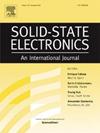Colossal permittivity and defect-engineered conduction in Ag/Al/SiO2/Si/Ag MIS structures for next-generation RRAM and 5G/6G capacitors
IF 1.4
4区 物理与天体物理
Q3 ENGINEERING, ELECTRICAL & ELECTRONIC
引用次数: 0
Abstract
The Ag/Al/SiO2/Si/Ag metal–insulator-semiconductor (MIS) structure exhibits remarkable dielectric and electrical properties, making it a promising candidate for next-generation electronic applications. This study systematically investigates the colossal permittivity, defect-mediated conduction, and relaxation dynamics of the dual-metal MIS structure using impedance spectroscopy, dielectric analysis, and AC conductivity measurements across wide frequency (1 kHz–20 MHz), temperature (80–400 K), and voltage (±5 V) ranges. Key findings reveal that the Ag/Al electrode configuration induces unique interfacial polarization effects, leading to ultrahigh dielectric constants (ε′ > 103 at low frequencies) and low loss tangents (tanδ < 0.1) suitable for high-frequency capacitors in 5G/6G technologies. The structure also demonstrates voltage-tunable resistive switching via Ag filament formation, enabling ultra-low-power resistive random-access memory (RRAM) with enhanced endurance.
Novelty: Unlike conventional Al/SiO2/Si devices, the dual-metal design leverages Ag’s high ionic mobility to modulate defect states and conduction pathways, resulting in: Colossal permittivity from space charge polarization at Ag/SiO2 and SiO2/Si interfaces. Defect-engineered conduction via thermally activated hopping and Fowler-Nordheim tunneling. Negative capacitance effects at high frequencies, attributed to charge trapping/detrapping dynamics.
New Applications:
RRAM: Controlled Ag migration enables nanoscale filamentary switching with low operating voltages (<3 V).
High-frequency capacitors: Stable ε′ and low tanδ up to 1 MHz meet demands for 5G/6G integrated passives.
Flexible electronics: Compatibility with polymer hybrids (e.g., PVA-SiO2) allows integration into stretchable substrates.
Challenges such as interfacial defect control and thermal stability are addressed, with proposed solutions including barrier layers and stoichiometric optimization. This work bridges fundamental dielectric spectroscopy with practical device engineering, offering a roadmap for advancing Ag/Al/SiO2/Si/Ag structures in nanoelectronics and beyond.
用于下一代RRAM和5G/6G电容器的Ag/Al/SiO2/Si/Ag MIS结构的巨大介电常数和缺陷工程导通
Ag/Al/SiO2/Si/Ag金属-绝缘体-半导体(MIS)结构具有卓越的介电性能和电学性能,是下一代电子应用的有前途的候选者。本研究系统地研究了双金属MIS结构在宽频率(1 kHz-20 MHz)、温度(80-400 K)和电压(±5 V)范围内的巨大介电常数、缺陷介导的传导和弛豫动力学,采用阻抗谱、介电分析和交流电导率测量。主要研究结果表明,Ag/Al电极结构可诱导独特的界面极化效应,从而获得适合5G/6G技术中高频电容器的超高介电常数(低频ε′>; 103)和低损耗切线(tanδ < 0.1)。该结构还展示了通过银丝形成的电压可调电阻开关,使超低功耗电阻随机存取存储器(RRAM)具有增强的耐用性。新颖:与传统的Al/SiO2/Si器件不同,双金属设计利用Ag的高离子迁移率来调节缺陷状态和传导途径,从而在Ag/SiO2和SiO2/Si界面上产生巨大的空间电荷极化介电常数。通过热激活跳跃和Fowler-Nordheim隧道的缺陷工程传导。负电容效应在高频,归因于电荷捕获/去捕获动力学。新应用:RRAM:控制银迁移实现低工作电压(< 3v)的纳米级丝状开关。高频电容器:稳定的ε′和高达1 MHz的低tanδ满足5G/6G集成无源的需求。柔性电子:与聚合物杂化(例如,PVA-SiO2)的兼容性允许集成到可拉伸基板中。解决了界面缺陷控制和热稳定性等挑战,提出了包括屏障层和化学计量优化在内的解决方案。这项工作将基本的介电光谱与实际的器件工程联系起来,为在纳米电子学和其他领域推进Ag/Al/SiO2/Si/Ag结构提供了路线图。
本文章由计算机程序翻译,如有差异,请以英文原文为准。
求助全文
约1分钟内获得全文
求助全文
来源期刊

Solid-state Electronics
物理-工程:电子与电气
CiteScore
3.00
自引率
5.90%
发文量
212
审稿时长
3 months
期刊介绍:
It is the aim of this journal to bring together in one publication outstanding papers reporting new and original work in the following areas: (1) applications of solid-state physics and technology to electronics and optoelectronics, including theory and device design; (2) optical, electrical, morphological characterization techniques and parameter extraction of devices; (3) fabrication of semiconductor devices, and also device-related materials growth, measurement and evaluation; (4) the physics and modeling of submicron and nanoscale microelectronic and optoelectronic devices, including processing, measurement, and performance evaluation; (5) applications of numerical methods to the modeling and simulation of solid-state devices and processes; and (6) nanoscale electronic and optoelectronic devices, photovoltaics, sensors, and MEMS based on semiconductor and alternative electronic materials; (7) synthesis and electrooptical properties of materials for novel devices.
 求助内容:
求助内容: 应助结果提醒方式:
应助结果提醒方式:


